Limehouse Basin Information & History
Built by the Regent's Canal Company and opened in 1820. By the mid 19th century the dock and the canal were a commercial success for the importance in the supply of coal to the numerous gasworks, electricity generating stations, homes and businesses along the canal. At one point it was the principal entrance from the Thames to the entire national canal network. Its use declined with the growth of the railways, although the revival of canal traffic during World War I and World War II gave it a brief swansong. Originally the Basin had three entrance locks to the Thames to separate ship and barge traffic. The smaller upstream entrances were later closed and filled. In 1968, a short stretch of new canal was constructed to reconnect the Limehouse Cut to the Basin, replacing the Cut's old direct link with the Thames. It was closed to commercial traffic in 1969, with one quay at the Basin retained for the use of pleasure craft. More at wikipedia | Also read lddc-history.org.uk >
View Photos of here and nearby locations | Buy Prints


















